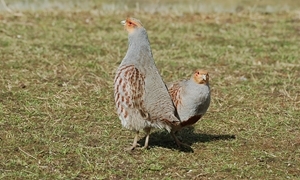 The wettest summer for 100 years in 2012 proved fatal for countless young partridge chicks but following a moratorium on shooting wild grey partridges last winter, the Game & Wildlife Conservation Trust (GWCT), reports that the over-winter survival of adult birds was nearly 46 per cent, which was much better than expected.
The wettest summer for 100 years in 2012 proved fatal for countless young partridge chicks but following a moratorium on shooting wild grey partridges last winter, the Game & Wildlife Conservation Trust (GWCT), reports that the over-winter survival of adult birds was nearly 46 per cent, which was much better than expected.
But as Dr Julie Ewald, a senior scientist with the GWCT reports, “We are delighted by the positive response from the shooting community and through their careful management efforts and reduced shooting, more adults survived the long winter than we expected. However this red-listed species is not out of the woods yet, having suffered a drastic decline of more than 86 per cent over the past forty years.”
Dr Ewald, explains, “Although this summer was much better than 2012, the late cool spring this year meant that early partridge broods in June struggled to find enough insects to eat. However, second broods in July, when the weather became much warmer, should lead to better survival rates of young chicks and we hope to see an encouraging upturn in our autumn counts.”
It is estimated that it will take grey partridges at least five years to recover from last year’s catastrophic breeding season. Dr Ewald said, “Despite all the efforts of those involved in partridge conservation, the one thing they cannot control is the weather. We expect our autumn counts will show that the population has done better than last year but it won’t be anything special and recovery to spring 2012 levels will take time.”
In the meantime, the GWCT is recommending that shoot owners, once again refrain from shooting grey partridges this winter unless they have more than 20 birds per 250 acres in the autumn.
To monitor this season’s breeding success, the GWCT is encouraging farmers, landowners and gamekeepers to get counting their grey partridges this autumn – even if only one or two birds are visible. Dr Ewald says, “It is vitally important that we know how many young partridges survived the breeding season this year so that we can see how they are faring. This also helps us to target conservation advice so that they can face a brighter future.”
To help the recovery of this once common bird, the Game & Wildlife Conservation Trust has published a free conservation guide that shows the type of year-round management needed to boost the grey partridge population. For a free copy email: domahony@gwct.org.uk or telephone: 01425 651060. To join the GWCT’s Partridge Count Scheme, which monitors the rise and fall of the national grey partridge population, please telephone 01425 651066 or email: nkingdon@gwct.org.uk
END
Photocaption: Grey partridges were once common across the country but the GWCT estimates that they will take at least five years to recover from last year’s disastrous breeding season.
Notes to editors
The Game & Wildlife Conservation Trust is an independent wildlife conservation charity which carries out scientific research into Britain’s game and wildlife. We advise farmers and landowners on improving wildlife habitats and we lobby for agricultural and conservation policies based on science. We employ 20 post-doctoral scientists and 40 other research staff with expertise in areas such as birds, insects, mammals, farming and statistics. We undertake our own research as well as projects funded by contract and grant-aid from Government and private bodies. The Trust is also responsible for a number of Government Biodiversity Action Plan species and is lead partner for grey partridge and joint lead partner for brown hare and black grouse.
For Information, contact
Morag Walker, Head of Media
Telephone: 01425-652381
Direct: 01425-651000
Mobile: 07736-124097
- The grey partridge, Perdix perdix is the only native partridge to England. It is a classic bird of traditional arable farmland and has the highest clutch size of any English bird, laying up to twenty eggs. It has a distinctive plumage of grey, orange and brown.
- Conservation measures devised by GWCT and in operation since 1999 have brought breeding density of grey partridges back to the levels of the early 1980s from an all-time low in 2001.
- Despite bad years in 1954 and 1972, breeding success in 2012 is the worst since GWCT records began in 1933 under the Partridge Count Scheme.
- The Partridge Count Scheme was set up in 1933 and encourages farmers to manage and conserve grey partridges on their land, using best practice examples and providing advice based on eighty years of GWCT research. Many other farmland species benefit from this management approach.